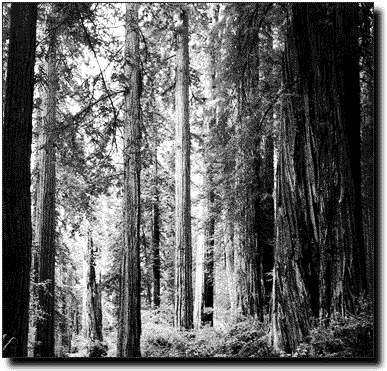

Two centuries ago, the climax redwood forest blanketed the Pacific Coast from southern Oregon to Big Sur, California. A century and a half of liquidation logging has destroyed more than 96 percent of that forest. Today, almost all of the ancient (some close to 2000 years old) stands are protected.
One of the largest debates occurring currently in California about deforestation centers around the Headwaters Forest(where is the headwaters?). It contains six groves of the oldest and tallest trees in the world. Headwaters is the only old-growth redwood forest still remaining under private ownership and thus is unprotected. Headwaters Forest forms a critical ecological link between redwood parks to the north and south, and provides refuge for plants and animals dependent on the ancient redwood ecosystem. The forest provides habitat for endangered species such as the California black bear, mountain lion, Pacific fisher, marbled murrelet, northern spotted owl, torrent salamander, tailed frog, steelhead trout, and coho salmon. Their survival is dependent on a diverse and healthy old-growth forest. The Pacific Lumber Company owned the Headwaters Forest for over a century, then in 1986 it was purchased in a hostile takeover by Charles Hurwitz, owner of Texas based Maxxam Inc. He immediately announced that, in order to pay off the bonds that were issued to finance the takeover, all of the old redwoods would be logged by 2007. It was apparent that the only way to save the Headwaters Forest would be to buy it from Hurwitz. The government announced a plan in February 1998 for a 50-year Habitat Conservation Plan . The proposal was endorsed by the U.S. Departments of Interior and Fish & Wildlife, National Marine Fisheries Service, California Governor Pete Wilson, the California Resources Agency, and the Pacific Lumber Company and its parent company. Under the plan, the California and U.S. governments would pay the Pacific Lumber Company $300 million for 5600 acres of the old-growth forest, also giving Pacific Lumber Company 7700 acres for compensation. Environmental groups all over, including Earth-first, are demanding that more of the forest be saved, almost 60,000 acres, including all six of its old growth stands. The 60,000-acre area includes approximately 40,000 acres that the US Fish and Wildlife Service designated as critical habitat for the endangered marbled murrelet in May 1996, and an additional 15,000-acre area to the north for protection of coho salmon habitat in the Elk River watershed. According to government sources, however, it is not economically feasible to purchase that amount of forest.
to find out more about how you can help, or to get more information, check out these pages:
get on the headwaters mailing list for weekly updates:
email listproc@envirolink.org subject:blank body:subscribe Headwaters Yourfirstname Lastname Affiliation